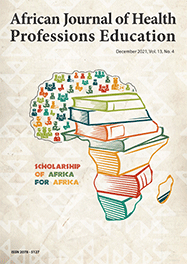Research

Challenges and opportunities related to postgraduate evidence based practice module using blended learning
Jose Merle Frantz, Simon Himalowa, Wallace Karaguti, Anne Kumurenzi, Mary Sakala, Davie Mulenga
Abstract
The use of information and communications technology (ICT) has become integral to health professions education worldwide. The incorporation of online facility and maintaining of face-to-face element make blended learning the “best of both worlds.” Blogs can be used to create a relatively learner-centred environment that allows students to learn at their own pace. Though blended learning has been proved to be appropriate in higher learning institutions, it comes with challenges and opportunities. Our study intended to highlight the challenges and identify opportunities encountered by an Evidence Based Practice (EBP) postgraduate class who used the blended learning model of learning. An action based research methodology was utilized in this study. This involved data gathering, action planning, action taking and action evaluation. Data was gathered through the use of a blog that was accessed by all participants. They made comments which were reflecting their perceptions on the model that was used for the course. The students gave consent to participate while permission from the physiotherapy head of department was also acquired. Deductive analysis was used for data analysis. The information from the blog was extracted and converted into text files. Coding and analysis into opportunities and challenges as expressed by the participants was performed. Theoretical saturation through every reviewer’s agreement and satisfaction about the information was included. The data consisted of 94 postings made of primary postings (22) and responses (72). All the authors acted as reviewers. Certainty was achieved by discussing any ambiguity in coding. Any necessary amendments were made. The participants reported to have experienced some challenges pertaining to blended learning. The blog that was used as a media between students and the facilitator was inefficient in some way. Some students could not access it when required and some resources in the blog were inaccessible. The wireless internet connection mainly used in this model was not reliable. However, there were opportunities experienced by the learners. These included easy interaction between the learners and the facilitator at anytime. The model also reduced instructor dependence and made the learners more responsible of their work. The blog appeared as a resource base for skills development. Timely feedback involving solving the problems students encountered during the course improved the communication skills between the students and the facilitator. However, technology constraints involving the blog and the internet connection were overwhelming among the students while writing up the tasks allocated to them. Despite the fact that students faced some challenges, facilitators of blended learning such as the interaction between the students and the facilitator of the course were motivating to keep the course interesting. While students experienced some opportunities about blended learning, its future rests on averting the challenges associated with it more especially in developing countries. If the challenges reported would be addressed in developing countries, blended learning can be effective in building student’s engagement and relieving of overcrowded classrooms in higher learning institutions.
Authors' affiliations
Jose Merle Frantz, University of the Western Cape
Simon Himalowa, University of the Western Cape
Wallace Karaguti, University of the Western Cape
Anne Kumurenzi, University of the Western Cape
Mary Sakala, University of the Western Cape
Davie Mulenga, University of the Western Cape
Keywords
self directed learning, reflections, evidence based practice, postgraduate, challenges and opportunities
Cite this article
African Journal of Health Professions Education 2011;3(1):15-18.
Article History
Date submitted: 2011-02-03
Date published: 2011-06-17
Article Views
Abstract views: 7930
Full text views: 3475
Comments on this article
*Read our policy for posting comments
here





.jpg)
Comments on this article
*Read our policy for posting comments here